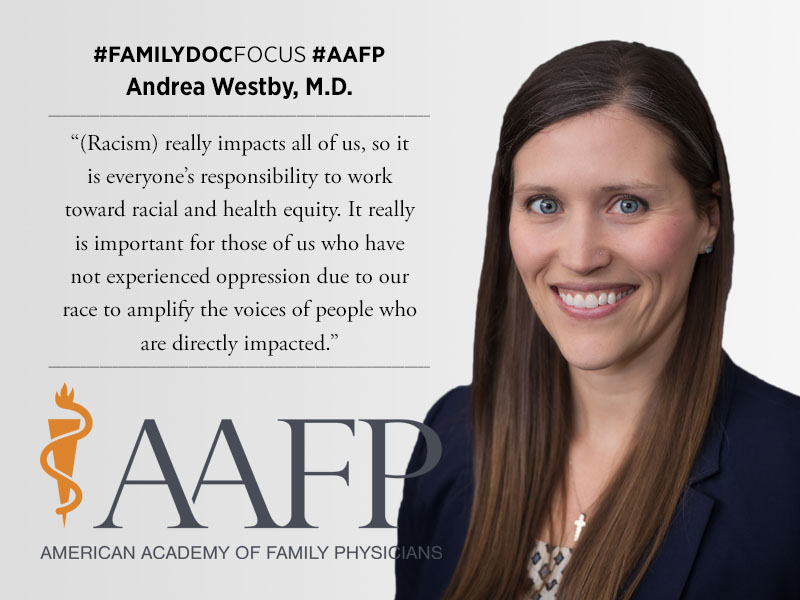Closing the Gaps on Health Disparities
July 20, 2021, 12:55 p.m. David Mitchell — As the white daughter of a cattle farmer and a librarian from rural Minnesota, Andrea Westby, M.D., may not seem the obvious choice to carve out a niche as an expert on health equity.

Then again, maybe that’s the point — that people, including physicians — should be aware of their biases and preconceived notions.
“Racism and racial health disparities are harmful to everyone,” said Westby, an assistant professor in the Department of Family Medicine and Community Health at the University of Minnesota Medical School and core faculty member at North Memorial Family Medicine Residency. “It really impacts all of us, so it is everyone’s responsibility to work toward racial and health equity. A lot of times people experience backlash when they talk about being personally marginalized, and there’s an extra emotional weight and psychological toll when that happens. It really is important for those of us who have not experienced oppression due to our race to amplify the voices of people who are directly impacted.”
Westby grew up in a working-class family in Pelican Rapids, Minn., a town of roughly 2,500 that has a relatively large minority population drawn by a refugee program and jobs at a poultry processing plant.
“I had some awareness of the ways that living in a rural community and not having a lot of financial privilege impacted how I experienced the world and what I had access to,” Westby said. “Then I practiced in rural Minnesota and saw that for my patients as well. That sparked this interest in really trying to figure out how to pay attention to disparities and direct resources to prevent them.”
Westby spent her first four and a half years after residency practicing full-scope family medicine in Perham, Minn., another small town about 30 miles from where she grew up. Medical students rotated through her clinic and hospital, but she wanted to make a bigger impact on physician training.
“I found that I really missed being surrounded by learners and having the energy, engagement and excitement of being on the cutting edge of family medicine education,” said Westby, who moved on to the University of Minnesota Medical School in 2017. “It’s also about the magnitude of impact. I think about it almost like Charlotte’s Web. You send all of these really impactful baby spiders out into the universe to create their own webs, and it’s really fun to see them grow.”
Westby practices and teaches in an area of north Minneapolis that is primarily Black and has been historically marginalized and disadvantaged. Last year she took on the role of vice chair for equity, diversity and inclusion in the Department of Family Medicine and Community Health, which has eight family medicine residency programs, four fellowship programs, and houses the Institute for Sexual and Gender Health and the Program in Health Disparities Research at the University of Minnesota.
“With the training programs, we are evaluating how programs decide who to interview and working on reducing the implicit and explicit bias that comes out in interviews and applications,” she said. “We’re having conversations about the selection criteria that we’re using, finding different ways to look at people’s backgrounds and histories that take into account their lived experience, resilience and backgrounds in a way that advantages instead of disadvantages them and asking ourselves if the selection criteria that we’re using achieves the end we want, which is a more diverse representative workforce for family medicine.”
Westby also is helping trainees and faculty look at race and bias in clinical practice. In one project, for example, residents tracked where they encountered recommendations for treatment decisions or diagnostic considerations based on race. They zeroed in on five common areas: cardiovascular disease risk calculations, glomerular filtration rate, hypertension, postpartum hemorrhage risk scoring and vaginal birth after cesarean, and then the residents examined the primary literature behind race-based algorithms and tools that use race as a risk factor.
“We’re looking at the literature and seeing how those conclusions were made and how it’s being used and determining whether using it leads to more equity or whether it leads to more racial and health disparities,” said Westby, who adapted this project into a fourth-year medical student curriculum and expanded the reach of her race-based medicine tracking tool by adapting it for the Institute for Healing and Justice in Medicine, a national organization that is working to eliminate the use of race as biology or genetics in clinical decision-making.
Westby will be one of the panelists in a Sept. 29 discussion regarding health equity during the virtual Family Medicine Experience.
“What I’d like people to think about is that we can individually make choices in how we practice that advance equity,” she said. “We can evaluate the existing research and make decisions at the point of care that are informed from the data itself and are equity focused. If we see that something in a guideline is going to worsen disparities, we can question the guideline and can apply it in a way that actually is going to move our individual patients and our communities toward better health.”